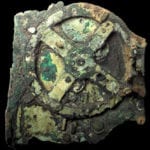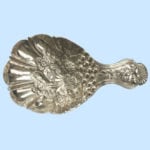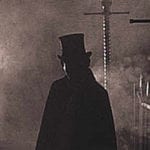 Mysteries
Mysteries  Mysteries
Mysteries  History
History 10 Surprising Stories About the Texas Rangers
 Humans
Humans 10 Philosophers Who Were Driven Mad by Their Own Theories
 Miscellaneous
Miscellaneous 10 Video-Game-Worthy Weapons and Armors from History
 Weird Stuff
Weird Stuff 10 Psychics Who Accurately Predicted Wartime Events
 The Arts
The Arts 10 Pieces of Art Inspired by a Broken Heart
 Health
Health 10 Science Fiction-Sounding New Medical Treatments
 History
History 10 Surprising Facts About the Father of Submarine Warfare
 Space
Space Ten Astonishing New Insights into Alien Worlds
 Weird Stuff
Weird Stuff 10 Bizarre Summer Solstice Rituals Still Practiced Today
 Mysteries
Mysteries Top 10 Haunting Facts About the Ghost Ship MV Alta
 History
History 10 Surprising Stories About the Texas Rangers
 Humans
Humans 10 Philosophers Who Were Driven Mad by Their Own Theories
Who's Behind Listverse?

Jamie Frater
Head Editor
Jamie founded Listverse due to an insatiable desire to share fascinating, obscure, and bizarre facts. He has been a guest speaker on numerous national radio and television stations and is a five time published author.
More About Us Miscellaneous
Miscellaneous 10 Video-Game-Worthy Weapons and Armors from History
 Weird Stuff
Weird Stuff 10 Psychics Who Accurately Predicted Wartime Events
 The Arts
The Arts 10 Pieces of Art Inspired by a Broken Heart
 Health
Health 10 Science Fiction-Sounding New Medical Treatments
 History
History 10 Surprising Facts About the Father of Submarine Warfare
 Space
Space Ten Astonishing New Insights into Alien Worlds
 Weird Stuff
Weird Stuff 10 Bizarre Summer Solstice Rituals Still Practiced Today
Top 10 Victorian Era Inventions That Were Ahead Of Their Time
From railroads to telephones, and from bicycles to electric lights, the world in 1900 was very different from the world of 1800. Of course, for every successful invention, there were hundreds of failures—ideas that did not work, or that nobody was interested in. There was also a third category: inventions that succeeded but years after they first appeared. The inventors had a great idea, but a vital material or bit of technology was missing, so the first try failed.
10Talking Doll
Thomas Edison
Dolls that speak have been around for a long time. They range from pull-string types like Toy Story’s Woody to present-day computerized models. However, the first talking doll to be put on sale proved to be a huge failure for America’s most famous inventor.
In 1877, Edison invented the phonograph, and by 1890, there was a version small enough to be fitted into the body of a doll. The appeal of a doll that talked seemed obvious. It was certain to sell well. An Edison factory in New Jersey began producing dolls that could recite a 20-second-long nursery rhyme. The rhyme for each doll had to be individually recorded, so women sat in booths at the factory making copy after copy of “Jack and Jill” or “Hickory Dickory Dock.” To hear the doll speak, the lucky child given it had to turn a crank on its back.
The dolls were big (22 inches tall), heavy (4 lb) and expensive ($10—equivalent to over $200 now). They were a commercial disaster. The phonograph was not robust enough to cope with rough handling by children, the sound quality was awful, and the crank was easy to lose.
Having been launched in April 1890, they were withdrawn from sale in May 1890 following a torrent of complaints and returns. Edison was left with 7,500 unsold dolls and a storeroom full of parts. The inventor himself described the dolls as “little monsters“—but if you find one in your attic, it will be worth a small fortune.
9Atmospheric Railway
I K Brunel

Isambard Kingdom Brunel was a brilliant engineer. He built spectacular railroads, ships, and bridges. In 2002, he came second in a BBC vote to find the Greatest Briton. His genius meant that he was never afraid to try out new ideas, but these innovations did not always work.
Brunel spent much of the 1840s building the Great Western Railway. This runs from London down to the far western tip of England. Part of the railway went through hilly terrain in the county of Devon and Brunel decided to try a new way of moving trains—an atmospheric railway.
There were no locomotives. Instead, stationary steam engines created a vacuum in pipes laid between the tracks. The vacuum then pulled the trains. The system worked, pulling the rolling stock along at about 20 miles per hour, but there was a fatal flaw.
The pipes needed a flexible seal. The only suitable material available at the time was leather, and the only way of keeping the leather flexible was regularly coating it in tallow (animal fat). If you are a rat, a tasty bit of leather dipped in fat is a wonderful meal. The local rats soon got into the habit of gnawing their way through the leather seals and bringing the trains to a halt. After less than a year, Brunel had to admit defeat and revert to conventional locomotives.
Modern materials mean that atmospheric railways are now a reality. Called Aeromovel, one system operates at a Brazilian airport and a second is under construction in the Brazilian city of Canoas.
8Indoor Ice Rink
John Gamgee

In April 1876, the world’s first indoor skating rink using real ice opened for business. Situated in Chelsea, London, it had been built by John Gamgee and was called the Glaciarium.
The ice surface was just 37 feet by 24 feet, but it worked in much the same way as today’s rinks. A refrigerating machine outside the rink cooled down a liquid that flowed through a network of pipes across the floor of the rink. The surface was then flooded with a thin layer of water, and the cold pipes froze the water, creating a solid sheet of hard, smooth ice.
What a visitor from the 21st century would find most incongruous about John Gamgee’s Glaciarium would be the boiler house next to the rink building, complete with chimney belching smoke. Both the refrigerating machinery and the circulating pumps were powered by a steam engine. The creation of the ice-rink relied on a stoker shoveling coal.
Three more rinks were built using Gamgee’s patent, including one in a floating swimming pool on the River Thames. They all failed commercially. They were just too expensive to build and run. The first artificial rink in the USA opened at Gilmore’s Garden (a predecessor to Madison Square Garden) in 1879, but this also had a short life. It was the end of the century before technology had caught up with the concept and public rinks began to appear, and operate at a profit, in major cities.
7Vacuum Cleaner
Hubert Booth

In 1901, Hubert Booth watched a demonstration of cleaning machine that worked by blowing dust. He was sure sucking up the dust was a better idea. Being a practical man, he tested his theory out. He laid a handkerchief on the seat of a railway car and sucked through it with his mouth (do not try this at home!). When he saw how much dust was on the other side of the handkerchief, he knew he was on to a winner.
Booth designed a horse-drawn machine powered by an internal combustion engine. London householders booked his services, and Booth’s vacuum cleaner came to their street. With the machine parked outside, hoses were passed through the windows, and the rooms cleaned by suction.
For several years, the business was successful. Then in 1907, on the other side of the Atlantic, a janitor in Ohio came up with his own invention. James Spangler had put together an electric motor, a fan, and a pillowcase to make a small portable cleaning machine. He called it the Electric Suction Sweeper. Spangler struggled to sell his invention and in 1908 sold his patent to the husband of a cousin. The husband’s name was William Hoover. The rest is history, and the days of Hubert Booth’s giant street-based vacuum cleaner were numbered.
6Great Eastern
I K Brunel

Isambard Brunel had already built two steamships, the Great Western and Great Britain, when he came up with the idea of a huge vessel that could travel from the UK to India without needing to refuel with coal. The theory was that economies of scale would make the cost per passenger, or per ton of cargo, much lower than on an average-sized ship.
Launched in 1858, the SS Great Eastern was 692 feet long. In terms of volume, she was eight times bigger than a typical ship being built at that time. It would be 41 years before a larger ship was built. There were many problems during the construction and launch, and the ship never operated at a profit carrying passengers. If anything, she was too big. Designed to carry up to 4,000 passengers, she never carried anywhere near that number. Several different companies went out of business trying to make money from voyages across the Atlantic.
Finally, in 1864, the Great Eastern was sold for just £25,000, despite having a scrap value of £100,000. The new owners refitted the ship and used it to lay the first telegraph cable across the Atlantic. This provided instant communication between North America and Europe for the first time. Over the next 14 years, she went on to lay over 30,000 miles of cable on the seabed around the globe. Brunel’s huge ship had finally showed its worth.
5Antiperspirant
John Gamgee

John Gamgee, the man who invented the ice rink, was also interested in public health. In the 1870s, he spent time looking for a new disinfectant and came up with a substance he called “Chloralum” (hydrated chloride of aluminum) that he claimed worked as a “very powerful and effective antiseptic, disinfectant or deodorizer.”
Gamgee took out a patent, and The Chloralum Company Ltd was formed to exploit this new substance. The only buyers were breweries using it to disinfect barrels. The company was dissolved in 1885, and John Gamgee almost certainly considered Chloralum to be a failed project.
If he had lived at a later time, when body odor was more of a concern to the general population, John Gamgee may well have become a very rich man. His patent for Chloralum has been cited by the multi-national company Unilever in patents relating to “antiperspirant compositions and method for reducing perspiration” with one of the patents being granted as recently as 2015.
If you pick up a can of aerosol deodorant from a supermarket shelf and look at what it contains, you will probably find “aluminum chlorohydrate” high on the list. Every day, millions of people squirt a little bit under their arms, and the lives of those who live and work with them are slightly less smelly. So next time you are squashed in a hot and crowded lift, bus, or train, and the body odor is not too overwhelming, say a little thank you to Professor John Gamgee.
4Panama Canal
Ferdinand De Lesseps

From 1859 to 1869, Ferdinand de Lesseps supervised the building of the Suez Canal. 120 miles long, the canal connected the Mediterranean Sea to the Red Sea and knocked 4,000 miles off the journey from Europe to South Asia.
Having successfully completed one canal, de Lesseps then turned his attention to Central America. He promoted the idea of a canal between the Atlantic and Pacific Oceans at Panama. By 1880, he had raised funds and was ready to start work.
However, there was a huge difference between the two canals. The Suez Canal had been dug through sandy soil, with the surrounding land barely above sea level. In Panama, the plan was to also keep the canal at sea level. This meant blasting a cutting through a 300-foot hill of solid rock.
De Lesseps was a diplomat and promoter, not an engineer. The construction was a disaster. Work proceeded at a snail’s pace, and thousands of workers died of yellow fever and malaria. By 1888, the idea of a sea-level canal had been abandoned, and the great French engineer Gustave Eiffel (of tower fame) was brought in to design the necessary locks.
The following year, the money ran out, and all work stopped. Worse, having raised millions of francs without any sign of an end product, de Lesseps, his son, and Gustave Eiffel were all charged with fraud. The “Panama Affair” scandal killed any chance of a French-built canal.
In 1904, the USA took over the project, and work restarted, using much more advanced excavation equipment. The canal finally opened in 1914, 24 years after de Lesseps had started work.
3Telephone Recording Machine
Edison/Bell

In 1881, the Philadelphia Local Telegraph Company linked up an early telephone to one of Thomas Edison’s phonographs. The aim was to create a machine to record telephone conversations. It was not voicemail but a system for recording a telephone call in full, to be used in the event of a dispute about a business call. The concept of “Calls may be recorded for monitoring purposes” goes back nearly 140 years.
The device was a prototype, and Edison seemed to feel his work was done. In a newspaper article, he was quoted as saying, “There’s the invention, and it’s only a mechanic’s job to make it marketable.” Unfortunately, turning the machine into something people would want to buy seems to have been too much for the mechanic on this occasion. The world had to wait until the 1940s for voicemail to become a reality.
2Airship
Jules Henri Giffard

By the 1850s, both hot-air and hydrogen balloons were well-established ways of getting airborne. The problem was that there was no way to control either the direction or speed of flight. You just went where the wind took you.
Then 1852, the Frenchman Jules Henri Giffard managed to build a lightweight steam engine. Lightweight is a relative term, and Giffard’s engine tipped the scales at 250 pounds. The fuel and water added another 150 pounds. However, this could still be carried aloft by a hydrogen balloon.
Giffard fitted his engine to a 144-foot-long balloon. It powered a three-bladed propeller, 10 feet in diameter, and the airship was also equipped with a large rudder. On September 24, 1852, Giffard took off from Paris and flew 17 miles. During the flight, he managed to steer his airship in circles, making this the first ever powered and controlled flight.
Unfortunately, Giffard’s small steam engine was not powerful enough to overcome the wind and fly him back to his starting point. He was stuck with a one-way trip and still at the mercy of the wind except in very calm conditions. Practical airships had to wait for the lighter and more powerful internal combustion engine.
1Computer
Charles Babbage

In the early 19th century, anyone who needed to use mathematical calculations as part of their work used printed tables. This included a lot of people—for example, navigators, engineers, bankers, insurance brokers, and architects. The problem was that the tables were calculated by hand, copied by hand, and then typeset by hand before being printed. There were errors, and sometimes these errors had fatal consequences for seafarers and engineers.
Charles Babbage, a mathematical genius based at Cambridge University, came up with the idea of a mechanical calculating machine. This would eliminate the errors. He called his machine the Difference Engine. He persuaded the British Government to finance the project, and for several years, work progressed. The Difference Engine had 25,000 parts and would weigh about 4 tons when finished. Then in 1833, Babbage fell out with his toolmaker, and construction stopped. Thousands of parts were melted down and sold for scrap.
Undeterred, Babbage began work on a second machine, Difference Engine 2, which was bigger and would weigh 5 tons. He also designed an Analytical Engine. This had all the elements of a computer such as a memory and the ability to run programs. The programs were based on punched cards. Ada Lovelace, the daughter of the poet Lord Byron, worked with Babbage on the Analytical Engine and has a claim to be the first computer programmer.
The mechanical complexity of the designs and Babbage’s often cantankerous personality meant that the Analytical Engine and the Difference Engine 2 were never built at the time. However, two working replicas of Difference Engine 2 now exist, one in London and one in California.
I am an aging English geek who is fascinated by odd history. I’ve put together some of my favorite stories at thequirkypast.com.








